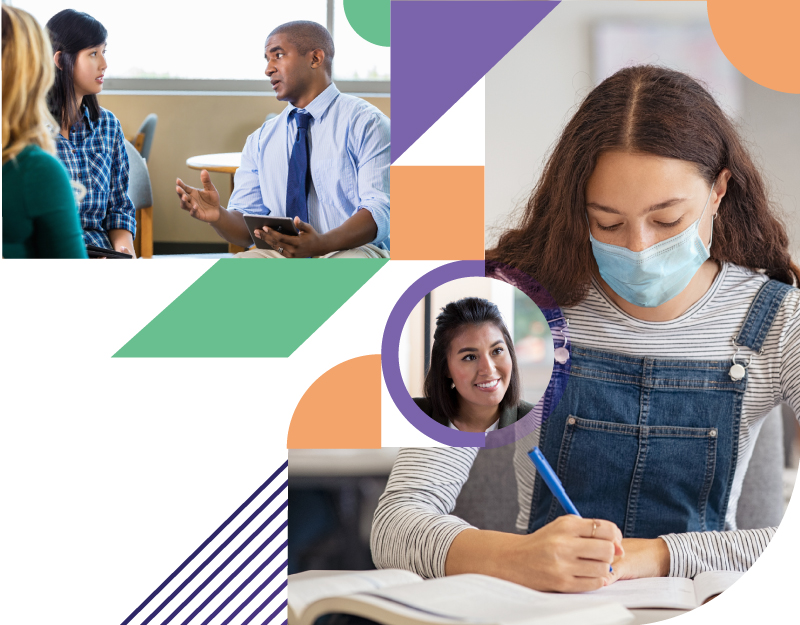Secondary Education
Both vocational rehabilitation agencies and schools are required by law to provide transition services and supports to improve post-school outcomes of students with disabilities. There are specific transition activities that schools are required to address for students with disabilities. The information below is about Transition planning and services required by schools.
Secondary education, both middle and high school, plays a critical role for providing students with the coursework, experiences, and opportunities for success in life beyond high school.
Keep in mind, Transition Across the Lifespan and Transition Planning is a Process that is multi-year.
Effective Transition Planning and Services
Effective transition planning and services are critical post-school success in education, training, integrated employment, and independent living or community engagement. Multiple factors contribute to successful life after high school. Predictors of post-school success inform the NTACT:C technical assistance and resources.
Specific planning and service requirements for transition-age students have been included in the Individuals with Disabilities Education Act (IDEA) since the 1990 reauthorization, including the term transition services. The purpose for transition services, coordinated by schools, is to facilitate students with disabilities moving from school to post-school activities. In this process, students with disabilities, families, educators, community service providers, VR counselors, employers, and others who are key to a student’s life should collaborate to achieve this purpose.
Source: IDEA (2004) definition of Transition Services 300.43
Measurable Post-School Goals
The measurable post-school goals in a student’s IEP, created from student input on their preferences, interests, strengths, and needs, drive the student’s educational program while in middle and high school. This may look different for each student:
- One student may focus their high school courses, work-based learning, and other experiences on a specific career (e.g. nursing, construction, mechanic, welding, etc.);
- Another student may take courses with multiple accommodations and adaptations and include applied learning activities and explore a variety of jobs; and,
- Another will take college prep courses and participate in comprehensive service learning project.
College, career, and community readiness is a goal of education for all students. Secondary education refines the focus on preparing all students for adult living and what’s next after high school. Coursework, school or community-sponsored extracurricular activities, and employment are the basis of that preparation. For students with disabilities their Individualized Education Program (IEP) documents post-school goals, annual goals and needed supports and services to achieve those goals

What's New
Getting Started Resources
Getting Started Training
- Predictors of Post School Success
- Effective Practices and Predictors in Secondary Transition
- From Assessment to Practice: A Model for Teachers
- Transition Fair Toolkit
- Student Progress Monitoring Toolkit
- Indicator 13 Checklists & Case Study IEPs
Key Resources
- Transition Across the Lifespan
- Side-by-Side View: Transition Services
- Middle School Transition Planning Practices
- Career and Technical Education & Secondary Students with Disabilities Quick Guide
- Positive Behavioral Interventions & Supports (PBIS) High School Implementation
- Secondary School-wide Positive Behavioral Interventions & Supports (PBIS) Tier 2 Quick Guide
- Universal Design for Learning at the Secondary Level
- Transition Planning is a Process
- ABLE Youth Transition Toolkit
- The Role of Centers for Independent Living
- PreK-Post12 Predictors of Success and Sample Activities
Key Training
Related Topics
Transition Planning
IEP Development, WIOA Requirements, Program Structure, and Student Development. More about Transition Planning.Postsecondary Education
There are a multitude of education and training opportunities students and youth with disabilities can participate in after high school. These resources can help prepare them for different expectations in different education environments. More about postsecondary education.Interagency Collaboration
Best practices for interagency collaboration to increase opportunities for competitive, integrated employment for students and youth with disabilities. More about interagency collaboration.Pre-Employment Transition Services
Training to begin exploring jobs and career interests through additional VR services and in collaboration with state and local education agencies to students with disabilities. Explore options on how to make available to all students with disabilities who need those services. More about Pre-Employment Transition Services.Employment
Under federal law, people with disabilities participating in vocational rehabilitation must be given the opportunity to obtain competitive integrated employment. Early work experiences, work-based learning, career exploration, self-determination, and other practices leading to future work success are explored.Graduation / Dropout
Strategies to reduce the dropout rate and increase graduation rate of all students with disabilities. More about graduation and dropout prevention planning.


